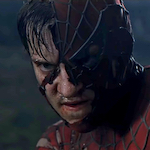 “He had an uneventful childhood. He played baseball with the other kids on the block, became fascinated with the antics of what later became his heroes – The Three Stooges, read Spiderman comic books, thought Jerry Lewis was hilarious and the Little Rascals even more so. What influenced Raimi to become the ‘horror meister’ of slash and gore films is not found in his past.”
“He had an uneventful childhood. He played baseball with the other kids on the block, became fascinated with the antics of what later became his heroes – The Three Stooges, read Spiderman comic books, thought Jerry Lewis was hilarious and the Little Rascals even more so. What influenced Raimi to become the ‘horror meister’ of slash and gore films is not found in his past.”
—Dead Auteur: How a 20-year-old ex-college student carved out his horror niche in Hollywood by Sue Uram, Cinefantastique, August 1992
Immediately following Raimi’s very serious director period, his career changed drastically again. After so many stabs at the mainstream, he finally made the leap to genuine blockbuster filmmaking, bringing one of the most famous characters in the history of American pop culture to the big screen for the first time. This is not the use-Intro-Vision-to-stretch-the-budget-enough-to-try-to-compete-in-summer of DARKMAN and ARMY OF DARKNESS, or the work-with-huge-stars-but-scare-off-boring-people-by-doing-something-different-with-them of THE QUICK AND THE DEAD. I’m talking a super hero event movie with ten times the budget of DARKMAN, working with Sony Digital Imageworks to pioneer effects techniques that nobody was even sure would be possible, and finally sharing his talents with pretty much the widest audience possible for a movie.
When he was hired to direct SPIDER-MAN, Raimi talked a good game about Peter Parker being a normal teenager with normal teenager problems, and about how he wanted to shoot the web-swinging like a dance sequence. He was clearly a great choice who had more than earned the opportunity, and there was precedent for this sort of thing: a few years earlier the guy who did BAD TASTE convinced them to let him do LORD OF THE RINGS. But it was still exciting to see another one of our guys, the guy who did EVIL DEAD, given the keys to Spider-Man.
And that was after a bunch more of “our guys” took a shot and missed . Through the ‘80s and ‘90s, most attempts at making movies out of Marvel Comics characters were seen as disreputable. HOWARD THE DUCK was expensive but hated, THE PUNISHER was more in a b-movie zone, and underappreciated. Marvel was so low rent that Cannon had the rights to their characters in the ‘80s, and directors who were attached to adapt Spider-Man include the guy who did THE TEXAS CHAIN SAW MASSACRE, the guy who did FRIDAY THE 13TH: THE FINAL CHAPTER and the guy who did CYBORG. After Cannon lost the rights, I think the fact that post-T2 James Cameron developed a version for several years, plus the success of BLADE and X-MEN, helped more people realize what an event the first Spider-Man movie could and should be, and expectations changed.
Mine were sky high, and at the time I thought this lived up to them, as did most people, as far as I could tell. (Come to think of it, I’m so old I have a record of exactly what I thought about it at the time.) The movie was a gigantic hit, making $825 million and helping pave the way for our current Marvel Comics based civilization. But I admit that at some point I rewatched it on DVD and didn’t like it quite as much, saw other versions of Spider-Man and thought I kind of liked them better, stayed away from this one for years. So it was really interesting to watch SPIDER-MAN again as part of my Sam Raimi studies. I don’t think I’d seen it since before the MCU started in 2008, and so much has changed since then.
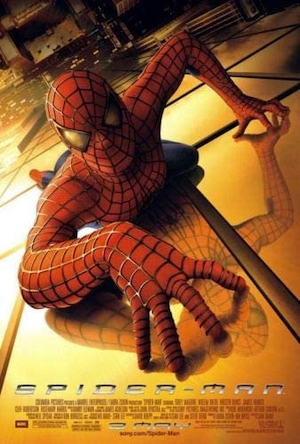 Unlike any of the previous super heroes that had been made into movies, Raimi’s Peter Parker (Tobey Maguire, seen as kind of an indie darling at the time because of THE ICE STORM and WONDER BOYS) is a genuine nerd. Like Ash in ARMY OF DARKNESS, he narrates the opening and closing of the film, telling the story of of his shitty life swerving into incredible adventures that nobody else knows about. But he puts more of a negative spin on it, like Darkman. “The story of my life is not for the faint of heart. If somebody said it was a happy little tale, if somebody told you I was just an average ordinary guy, not a care in the world, somebody lied.”
Unlike any of the previous super heroes that had been made into movies, Raimi’s Peter Parker (Tobey Maguire, seen as kind of an indie darling at the time because of THE ICE STORM and WONDER BOYS) is a genuine nerd. Like Ash in ARMY OF DARKNESS, he narrates the opening and closing of the film, telling the story of of his shitty life swerving into incredible adventures that nobody else knows about. But he puts more of a negative spin on it, like Darkman. “The story of my life is not for the faint of heart. If somebody said it was a happy little tale, if somebody told you I was just an average ordinary guy, not a care in the world, somebody lied.”
He’s introduced mid-humiliation, chasing and yelling after a school bus he missed. Throughout the series Raimi will get alot of mileage out of these comedy sequences that stack increasingly ridiculous embarrassments on poor Peter the way the Deadites piled grueling horror on Ash. Everyone on the bus laughs at Peter’s predicament, including the driver. We feel the weight of the whole school glaring at him as he does get on the bus. A nerdy girl won’t let him sit next to her. A big jock guy named Flash (who I now recognize as Joe Manganiello in his movie debut, ten years before MAGIC MIKE), trips him. Only his next-door-neighbor/life-long crush Mary Jane Watson (Kirsten Dunst, SMALL SOLDIERS, THE CROW: SALVATION) speaks up for him, but she’s with her boyfriend, the same guy who tripped him .
And the hits keep on coming when they arrive for their field trip to the genetics lab at Columbia University and he gets the old holy-shit-she’s-smiling-and-waving-and-coming-toward-me/oh-never-mind-she-was-looking-at-her-friends-behind-me-and-now-I-look-like-a-total-dipshit-because-I-smiled-and-waved-back.
The lab tour scene is carefully written to introduce a ridiculous number of elements. It’s where we meet Peter’s best friend, rich kid Harry Osborn (James Franco fresh off of Freaks and Geeks) and see that they’re both attracted to Mary Jane and try to talk to her in different ways. We see that Peter is a photographer, documenting the trip for the school newspaper. We hear that he lives with his aunt and uncle. We meet Harry’s dad, scientist and Oscorp CEO Norman Osborn (Willem Dafoe right before AUTO FOCUS), see that Peter idolizes him and wrote a paper on him, hear that he’s a pioneer in nanotechnology, and notice that Harry struggles to gain his respect and seems kind of jealous of how much he likes Peter. We see more of Peter’s scientific knowledge and enthusiasm through his comments during the tour.
And of course this is also where an escaped genetically altered red and blue super-spider bites Peter, causing an infection that will turn into super powers. Like Darkman before him, Spider-Man’s abilities are explained during a guided tour, as the guide (Una Damon, THE TRUMAN SHOW)’s spiel conveniently mentions features of different species of spider that align with what will be Spider-Man’s powers: strength, jumping, webs with “a tensile strength proportionately equal to that of high tension wire,” and (in an impressive stretch) “reflexes with nerve-conduction velocity so fast that some researchers believe it almost borders on precognition. An immminent awareness of danger, a spider-sense.”
Peter also mentions spiders being able to change color like chameleons, ‘cause he doesn’t know this is supposed to be foreshadowing, he thinks they’re just listing different facts I guess.
A reoccurring issue in this trilogy will be characters having freak accidents with bizarre health effects and then not telling anyone or getting medical help. Also known as “pulling a Darkman.” But it makes sense with Peter’s working class background and working as a freelancer that he wouldn’t have good insurance, if any, and would avoid going to the doctor.
We next see our budding super villain Norman Osborn on the job pitching his wares to the military assholes on his board of directors. They don’t give a shit that he “solved the horizon glide and the multi-G balance issues” with the jet glider, they’re more concerned that the performance enhancers aren’t ready for human trials. They increased strength by 800% but had problems one of the times they tested them on rodents. (See a doctor and stop taking performance enhancement vapors if you experience side effects including violence, aggression and insanity.)
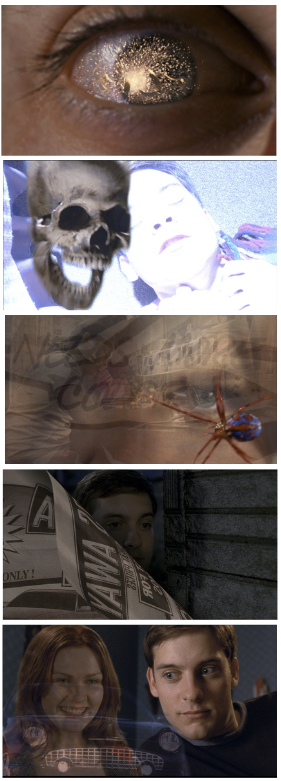
Speaking of side effects, Peter is at home feeling weird from the spider bite. Raimi and editor Bob Murawski (ARMY OF DARKNESS, HARD TARGET) and/or Arthur Coburn (BEVERLY HILLS COP, THE MASK, A SIMPLE PLAN, FOR LOVE OF THE GAME, THE GIFT) use a slightly subdued version of a DARKMAN type montage, with flashes of a skull, and zooms into a CG animation of Peter’s DNA as spiders crawl on it and replace parts of it with red and blue strands. There are several montages in this that look more digital and less hand-crafted than those in DARKMAN and THE QUICK AND THE DEAD, but they’re very much in the same spirit.
Peter discovers that he sees better with his glasses off, and looks buff in the mirror. And then he starts experimenting with climbing and swinging, in a very regular-guy-fucking-up kind of way. To this day the powers-related detail that’s most effective to me is the shot of the tiny little insect leg type things coming out of Peter’s fingertips, to explain how he grips the walls when he climbs them. It’s such a disturbing image and I totally buy that that’s how it would work. (At least when he’s not wearing gloves.)
Credited screenwriter David Koepp (I COME IN PEACE, TOY SOLDIERS, JURASSIC PARK, THE SHADOW) was first hired to rewrite from Cameron’s script, long after Cameron left. Koepp switched out the villains Electro and Sandman for Green Goblin and Dr. Octopus. When Raimi decided the latter wasn’t working he had uncredited rewriter Scott Rosenberg (DISTURBING BEHAVIOR, KANGAROO JACK) remove him, and then producer Laura Ziskin hired her Academy Award winning husband Alvin Sargent (GAMBIT, PAPER MOON, WHAT ABOUT BOB?) to polish the dialogue.
Everything I’ve read about Cameron’s version suggests a drastically different tone – not trying for a gee whiz old timey feel at all, but a modern cinematic reinvention of old shit. The one thing I know remains from Cameron’s draft is what they call “organic webshooters” – the spider bite causes Peter to grow orifices in his wrists that shoot the webs. This was hugely controversial among comic fans at the time because everybody knows Peter invented and built the webshooters and they are a mechanical thing attached to his wrist. (Okay, no, I honestly had no idea. I assumed the one obviously-spider-like-without-having-to-have-a-tour-guide-explain-it power Spider-Man had came from his famous spider bite.)
Noticing Peter’s being weird, Uncle Ben (Cliff Robertson, GIDGET, MALONE, ESCAPE FROM L.A.) says, “Teenagers. Raging hormones. They never change,” which is a joke about how much this particular teenager actually is changing, and also sets up a puberty parallel as Peter experiments with web shooting in his bedroom and his guardians seem to think he’s in there jerking off.
I would like to take a moment to honor how believable Uncle Ben and Aunt May (Rosemary Harris, briefly seen as Annie’s grandma in THE GIFT)’s apartment is – comfy but small and very much furnished like people their age would furnish it. I think it really captures that feeling of a teenager staying with their grandparents – his love for and responsibility to guardians of an older generation than his peers’ parents is formative for him, but also might make him different and socially awkward.
And please note that Uncle Ben driving the EVIL DEAD Oldsmobile is amazing because it’s an in-joke but also that is exactly the old-ass car he would drive. In fact, my grandpa drove an Oldsmobile.
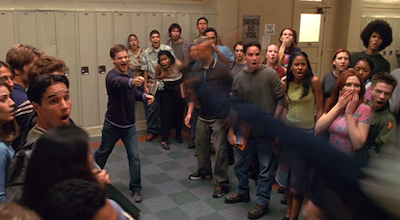 Raimi’s style is noticeable in the comical ways Peter’s powers come out. The part where Mary Jane slips in the cafeteria and Peter catches her, her tray, and then several flying lunch items on the tray, seems like it could almost fit into CRIMEWAVE somewhere. There’s physical comedy like getting his web stuck to a tray and accidentally flinging it at Flash. And the Raimi kineticism comes out when Flash tries to fight him and he dodges every punch, flips over him, punches him so hard he slides down the hall like in a kung fu movie. Later, Raimi-an visuals will include a transition from explosion debris to caps being thrown at Peter’s high school graduation, many zoom ins on Peter and other characters as their hair is being blown by the wind (or the rocket sled flying by), and Goblin blasting a hole through Aunt May’s apartment reminiscent of the tree monster breaking through in EVIL DEAD II.
Raimi’s style is noticeable in the comical ways Peter’s powers come out. The part where Mary Jane slips in the cafeteria and Peter catches her, her tray, and then several flying lunch items on the tray, seems like it could almost fit into CRIMEWAVE somewhere. There’s physical comedy like getting his web stuck to a tray and accidentally flinging it at Flash. And the Raimi kineticism comes out when Flash tries to fight him and he dodges every punch, flips over him, punches him so hard he slides down the hall like in a kung fu movie. Later, Raimi-an visuals will include a transition from explosion debris to caps being thrown at Peter’s high school graduation, many zoom ins on Peter and other characters as their hair is being blown by the wind (or the rocket sled flying by), and Goblin blasting a hole through Aunt May’s apartment reminiscent of the tree monster breaking through in EVIL DEAD II.
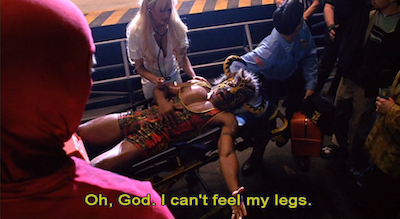
Sort of like that doofus in CRIMEWAVE trying to impress a woman and having to wash dishes to pay for their meal, Peter wants to buy a car to compete with Flash’s fancy ass ride and therefore enters a wrestling challenge. That scene is notable for
1. Featuring WWF legend “Macho Man” Randy Savage as “Bone Saw”
2. Letting Bruce Campbell cameo as the ring announcer, something he turns out to be very good at
3. Having maybe the first instance of the “shitty home made version of a famous super hero costume” trope, as Peter dons a ski mask and baggy red and blue clothes that almost look like pajamas.
(When Peter later has a professionally made suit based on his sketches it is extremely unclear where the fuck it could’ve possibly come from. The latex web pattern overlay was 3-D printed for the movie, so maybe he got help from Darkman.)
Raimi seems sincerely invested in the morality of Spider-Man. When the wrestling promoter who ripped Peter off (Larry Joshua, THE BURNING, UNFORGIVEN) then gets robbed, Peter pointedly does not stop the thief (Michael Papajohn, also in FOR LOVE OF THE GAME) and smiles about it like an asshole. Then the thief kills Uncle Ben in a carjacking, so Peter’s tough-shit-ism comes back at him immediately.
Later, as Spider-Man, he catches up with the carjacker, and his lust for vengeance is clearly over the line – when he bends the guy’s wrist backwards it reminds me of Darkman mangling that carnie’s fingers. Though the carjacker falling out a window to his death is an accident, it’s Spider-Man’s fault, and he is clearly more upset about it than Batman was when he accidentally dropped the Joker, or Darkman was when he intentionally dropped Strack.
One reason SPIDER-MAN seemed like such a comic book movie breakthrough at the time was the amount of visual and tonal brightness. It seemed more like what we thought of as “comic book-y” than the “dark” tone we desired throughout the ’90s. Though Peter really does alot of brooding, we focused on his relatable underdog qualities and occasional corny wisecracks and thought of him as much lighter than Batman. X-MEN had felt the (very real) need to dress everybody in black leather to seem cool to moviegoers of the time, but here was a Spider-Man that pretty much just looked the way Spider-Man had always been drawn. (They did consider a black costume, but thought better of it.) And after a decade plus of movies chasing the noir and gothic qualities of Tim Burton’s Gotham City, it was surprising to see one that just took place in regular contemporary New York City, sometimes filmed on location. And often in broad daylight! Even Joel Schumacher’s candy-colored BATMAN FOREVER and BATMAN & ROBIN took place mostly at night. And of course the breakthroughs in digital FX on BLADE II and then this ushered in the notion of comic book movies with action more in line with their illustrated source material. SPIDER-MAN seemed like a very natural, but very new place for the genre to go.
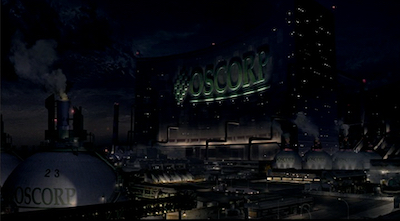
So it was interesting to look back at it from the MCU era and see how much more this resembles the Tim Burton BATMAN template than that of today’s comic book movies. It was logical for Raimi to go to his DARKMAN/A SIMPLE PLAN composer Danny Elfman for the score, but that was also what you did if you were trying to make any comic book movie after BATMAN. Because Elfman’s sound is so distinct and so evocative his scores leave a bigger mark on the tone of the movies than the work of almost any composer today. So it makes even SPIDER-MAN, so different from BATMAN, feel a little like BATMAN.
You just did it differently back then. You hoped for at best a couple sequels, and didn’t always get that, so you didn’t think too much about setting up the next one, and definitely didn’t think at all beyond that. You just took the origin story of the hero, and picked one or two of the most famous villains, and told their origin story too. And killed them at the end. And you worried that moviegoers would laugh at half of the shit that’s normal and acceptable in comic books, so you second guessed everything. You can’t make Green Goblin just have a goblin face and hat*, it was believed, so you’d come up with this high tech mask thing. But you’d have the flying sled! And the bombs! Not pumpkins, but they’re round at least. It counts! It’s like a comic book!
The part that seems most directly inspired by BATMAN is when Dr. Osborn debuts all that Green Goblin stuff at the World Unity Festival. In BATMAN, Gotham City is celebrating its bicentennial, and the Joker stages a big public attack during a parade. In BATMAN RETURNS the Penguin’s circus gang does similar during a Christmas tree lighting. In SPIDER-MAN the Green Goblin makes his first public appearance attacking this city-organized event, and just like in BATMAN there are big Macy’s Thanksgiving Day Parade style balloons involved. Because they’re not based on Tim Burton sketches and are surrounded by real billboards and very early-2000s-looking extras they’re uglier, but they get into the action because Spider-Man bounces off of them. It makes me wonder if Koepp or Raimi watched BATMAN and thought ah ha – we can top that because we can have him bounce off of them! Movie Batman could never bounce off of them!
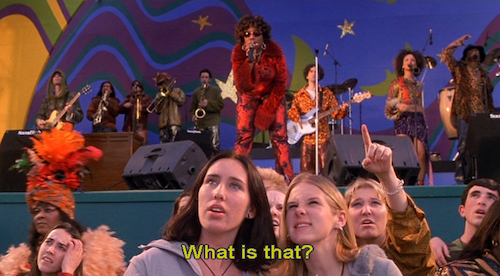
A couple more notes about the World Unity Festival. I’ve always enjoyed/been amused by the fact that Macy Gray is performing in this movie. Enjoyed because I like her and amused because her inclusion pins the movie to a specific moment in time. And I’ve always appreciated that she’s doing a cover of a song by an obscure band I was really into, hopefully getting them paid. (The song is “Nutty Nutmeg Phantasy,” the band is Weapon of Choice, led by the brother of her guitarist Arik Marshall, seen on stage with her here).
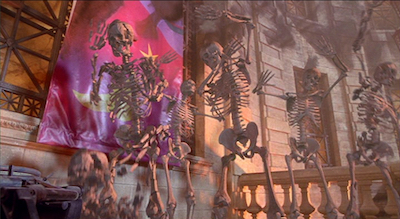 But the thing I did not remember is how buck wild Green Goblin goes. He throws a bomb on a balcony, turning his war profiteer board of directors into skeletons! It reminds me of MARS ATTACKS!, which is a compliment, but it would be even funnier if instead of CG they used skeleton puppets left over from ARMY OF DARKNESS. Oh well, maybe next time.
But the thing I did not remember is how buck wild Green Goblin goes. He throws a bomb on a balcony, turning his war profiteer board of directors into skeletons! It reminds me of MARS ATTACKS!, which is a compliment, but it would be even funnier if instead of CG they used skeleton puppets left over from ARMY OF DARKNESS. Oh well, maybe next time.
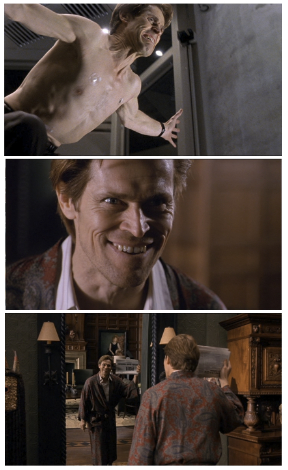 There’s a part where Goblin comes down to the street and a bunch of cops come at him and he punches out five of them in a row. Ahead of his time.
There’s a part where Goblin comes down to the street and a bunch of cops come at him and he punches out five of them in a row. Ahead of his time.
This portrayal of a super villain is very different from today’s comic book movies, which is part of why it’s so fun to watch now. I always got a kick out of the scene where he has a talk with Spider-Man on a roof and they’re both wearing emotionless masks so it almost seems like Power Rangers. But now I have a deeper appreciation for the audacity of Dr. Osborn going to graduation and giving his condolences to Peter about Uncle Ben just moments after we saw him fly in on a sled cackling and firing missiles at military guys. And for when he yells lines like “We’ll meet again, Spider-Man!” Dafoe is also great in the scenes where his innocent side is tormented by his evil Goblin voice coming from the mask, or by his own reflection in the mirror (a gimmick reminiscent of Ash talking to his evil reflection in EVIL DEAD II and ARMY OF DARKNESS). He’s definitely doing things with his face that normal humans could never dream of, and I think it’s fair to say he gets pretty mega.
I should address two of the traditional Spider-Man story elements adapted here. First, Peter working as a freelance photographer at the Daily Bugle newspaper. One of Raimi’s great contributions to cinema that I think we as a society take for granted is his casting J.K. Simmons as loud-mouthed, Spider-Man-hating editor J. Jonah Jameson. Simmons wasn’t particularly well known then but had been funny for Raimi in FOR LOVE OF THE GAME and THE GIFT. The comical banter (much of it yelled) between him and his staff is a highlight that seem both straight out of the comics and straight out of Raimi’s humor. For the latter it helps that Ted Raimi plays Jameson’s most ass-kissing employee. DO THE RIGHT THING’s Bill Nun and early-in-her-career Elizabeth Banks are also very good.
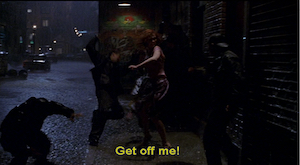 Second, the crimefighting. There are fast-paced montages of swinging in and webbing or punching various street criminal archetypes, another element that seems more of the BATMAN era, before super hero movies largely moved beyond vigilantism. Back then it was more standard that they would have to beat up some muggers, so I don’t even remember it striking me as weird that the famous upside down Spider-man/Mary Jane kiss in the rain happens moments after four guys jumped her in an alley. I have a pretty good hunch what they were trying to do, so I don’t see how she’s in the mood for romance so quickly!
Second, the crimefighting. There are fast-paced montages of swinging in and webbing or punching various street criminal archetypes, another element that seems more of the BATMAN era, before super hero movies largely moved beyond vigilantism. Back then it was more standard that they would have to beat up some muggers, so I don’t even remember it striking me as weird that the famous upside down Spider-man/Mary Jane kiss in the rain happens moments after four guys jumped her in an alley. I have a pretty good hunch what they were trying to do, so I don’t see how she’s in the mood for romance so quickly!
One thing Spidey gets to do that Batman doesn’t is save a baby from a fire. The best fight against Goblin also happens while responding to a fire.
It seems quaint now that Spidey’s big climax is just a fight against one guy flying around, causing trouble on a bridge, kidnapping Mary Jane and hanging her off a ledge (another DARKMAN similarity). The emphasis is not so much on the villain’s master plan as the effect it has on Peter’s personal life. He and pre-evil Osborn genuinely seem to like each other, and when the good/bad doctor dies and Harry blames Spider-Man it puts a wedge in their friendship, even while Harry doesn’t know Peter is Spider-Man.
All this makes Peter think he both has a responsibility to be Spider-Man and cannot be happy being Spider-Man. His dream of Mary Jane being in love with him finally comes true (she even chooses him over her previous crush, Spider-Man!) but he pretends not to feel the same and walks away. Once again this is like a teen version of DARKMAN – I love you but I can’t be with you because it’s too dangerous for you. Drama queen shit.
DARKMAN ended with him narrating, “I’m everyone… and no one… everywhere… nowhere. Call me… Darkman.” For SPIDER-MAN it’s, “This is my gift. My curse. Who am I? I’m Spider-Man.” They would pretty much be the exact same ending if only Darkman got to have a final shot posing in front of an American flag.
There is a major moment at the end here that I don’t think is really followed up on in the sequels. After Mary Jane kisses Peter, but is rejected by him, she’s feeling very sad and then suddenly she has this look of realization and touches her gloved fingers to her lips.
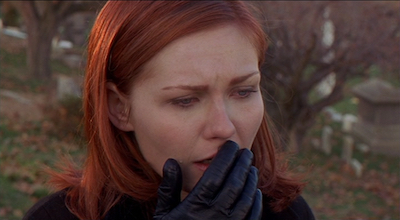
Then she looks back at Peter like “Holy shit!” I have replayed this moment over and over, and even though it doesn’t match with what happens in the next movie, I don’t see how it could’ve been meant as anything other than her suddenly realizing “Oh shit, I think he’s Spider-Man!” Or more specifically, “Oh shit, Peter’s mouth tastes like Spider-Man’s mouth!” That’s a weird loose end there.
In 2000, when Raimi was beginning work on SPIDER-MAN, he told Eon Magazine how he wanted to handle the web-swinging:
“What I want to do is show it like you’d show a great Olympic skating routine. He’s not a muscle bound brute. He is a live and beautiful dancer who soars above the skyline and it’ll be the work of an acrobat, the work of a gymnast, the work of all the finest performers in the art of physical what have you. But they are going to be long takes, like a Fred Astaire picture, of Spider-Man climbing and leaping off a building and doing a number on a flag pole like an Olympic gymnast. Then it will become the work of a dancer in the sky. I hope it will become a thing of beauty that 20 years from now people will still enjoy watching and we really get to fly with him.”
I am happy to report that 20 years from then I do still enjoy watching it. How well the FX – supervised by the legendary John Dykstra (STAR WARS, FIREFOX, LIFEFORCE, INVADERS FROM MARS) hold up was one of the biggest surprises of this rewatch. As I’ve alluded to, nobody really knew for sure if they could make a believable digital Spider-Man until they had done it. These days Hollywood movies do that type of stuff with their hands tied behind their back, you don’t even think about it when you’re looking at it. And yet these scenes with the early stages of that technology are a thrill to watch.
Maybe the limits of the technology helped – they were forced to plan each shot meticulously in order to get the live action they needed to work with the FX (and Raimi intentionally included live action elements in every shot so it wouldn’t look like cutting to animation). But we also have to credit Raimi’s well-established eye for cool visuals and exciting camera movement. There are shots where yes, you can tell it’s a real stuntman swinging on a rope, and it looks dangerous as hell. (I hope it was the same guy who hung from the helicopter into traffic in DARKMAN.) There are other shots that are definitely animation, and they look so beautifully graceful. But I think my favorites are when Maguire, with mask off – perhaps switching to a digital double sometimes, but I’m not sure – is crawling up the sides of buildings, the camera moves around him as if the building itself is tilting to become horizontal, and I gotta assume that’s how they filmed it but also I still feel like I’m looking down. Cinematographer Don Burgess was good at show-offy shots like this, having done a bunch of movies with Robert Zemeckis. And also BLIND FURY.
IMDb claims that the great Hong Kong choreographer and director Ching Siu-Tung was an uncredited stunt coordinator on the movie. I believe that’s incorrect, but has a basis in truth. According to an interview with Ching in Asian Trash Cinema, he was hired to consult on the movie when Raimi was worried the computer animation wasn’t going to work out. Turns out it did, so they didn’t need him. As great and groundbreaking as the web-swinging turned out, it’s hard not to wish we got to see Raimi and that budget meet up with a master of Hong Kong wire work. That would’ve been amazing! Damn you, Sony Pictures Imageworks for pulling off the digital FX. Assholes.
There’s definitely a little bit of wirework, and the fighting is pretty good, if not Hong Kong good. Clint Cadinha (SHOWDOWN IN LITTLE TOKYO, UNIVERSAL SOLDIER, RAPID FIRE, DEMOLITION MAN, THE CROW, UNDER SIEGE 2, THE MATRIX) is credited as fight choreographer, and Chuck Jeffreys (the mugger from GHOST DOG) as fight coordinator. Benny “The Jet” Urquidez (WHEELS ON MEALS, ROAD HOUSE) trained Maguire for the fights and plays one of the, uh, alley rapists. Laura Albert, the star of BLOOD GAMES, also did some stunts.
For all these years, Sam Raimi had been an underdog to us. First maybe you had to convince your friends to watch his movies. Eventually, most of your friends loved him too, but you all thought he deserved larger validation. You wanted DARKMAN to be recognized. You wanted THE QUICK AND THE DEAD to get the credit it deserved. When he got to make SPIDER-MAN, and was met with such success, it felt like validation. I don’t think we saw any of the downside yet. We didn’t know that now we were gonna have years of talking to people whose only opinion of Raimi was based on whether they agreed with his interpretation of their sacred Marvel scripture. More importantly, we didn’t know that he was gonna want to stay at this level, focused almost solely on directing huge, expensive blockbuster type movies, leaving behind much of what we loved about his films. But that’s okay. There is plenty to appreciate here, and we can worry about that other stuff later.
In the coming days we will be examining the SPIDER-MAN sequels, since they are Raimi’s next movies. Until then, I would like to leave you with one last note. The most important thing I realized from rewatching this trilogy is that I really wish I could’ve been one of those characters who appear in one shot pointing off in the distance and saying something like “Look! It’s Spider-Man!” I’m not an actor but I think I could’ve pulled off a role like that, and I think I would be able to live up to all the responsibilities that come with being a Spider-Man spotter.
*They did consider a more comics-faithful Goblin, with Amalgamated Dynamics even building an animatronic mask of it, but clearly they decided against it.



























January 26th, 2022 at 12:48 pm
This film really provided the signposts for most modern superhero films in the MARVEL CINEMATIC UNIVERSE.
It’s hard to quantify how much of a gigantic hit this film was – first movie to gross 100 million bucks in a weekend. The other thing I distinctly remember was that there was a sense of relief from comic books fans that this movie was well crafted and treated ‘superhero’s’ with a sense of intelligence in regards to creating a film – a big budget, good actors and some perceptive writing. From non-superhero fans there was a sense of ‘holy shit’ that was a GOOD movie.
This film was an event like Superman from 1978/Batman from 1989. Funny how a decade needs to go past for everyone to forget how good/successful a superhero movie can be, and that all 3 of these are still among the best superhero movies produced.
I’m good friends with a guy who has a copy of every single Spider-man comic book published, and his sense of joy about this film was pretty special. Eventually he sat down with me and pointed out scenes that were subtly influenced by scenes throughout the comics run. Even the way Raimi constructed sets and blocked scenes is subtly reminiscent of the way comic panels are laid out and drawn (especially those of Steve Ditko, the foremost Spider-man artist.) Even color choices on screen show resemblances to comic books. It’s all pretty perceptive stuff, and adds a real layer of enjoyment for comic book fans (as I was back then.) More recent super hero films make no effort to do this, and or are like Sin City/Watchmen – shameless exactly copying panels. What Raimi managed to do was take the best of what a comic does – color/layout/narrative clarity via a stationary image and mix in what cinema does better – dynamic movement, editing for emotion and music/sound design.
It is still pretty funky remembering the fun I had as well enjoying people’s excitement at the film, it’s safe to say 90%+ of people who saw this had never seen a Sam Raimi movie, and here was Raimi getting away with all the typical Raimi ‘moves.’ Admittedly dialled back some, but this is still undoubtably his film. It’s too bad that especially the MCU movies have became absolutely so generic and boring looking/shot and scored now.
Here’s hoping that the new Dr. Strange/Raimi joint lets him free – reports from the set insist he has been allowed to.
Briefly – I once read James Cameron’s ‘scriptment’ for Spider-man. Besides opening with what would have been a tremendous first shot of Spider-man dangling on a wire between the WTC buildings, and if I remember correctly, it most certainly had a scene where Peter Parker has a ‘wet’ dream and wakes up covered in ‘wire.’ The script was not shy about making a connection between adolescence/puberty and Peter getting his super powers.